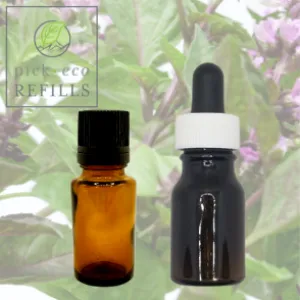Description: Basil Linalool essential oil is derived from the Ocimum basilicum plant, a variety of basil that is rich in linalool. Linalool is a compound known for its calming and soothing properties. Unlike other types of basil essential oils that may have a stronger scent, Basil Linalool is characterized by a milder and sweeter aroma.
Scent Profile: The scent profile of Basil Linalool is often described as:
- Aromatic: The oil carries a fresh and herbaceous aroma, reminiscent of traditional basil, but with a softer and more floral undertone.
- Sweet: Linalool imparts a sweet, gentle fragrance to the oil.
- Mild Spice: There may be subtle spicy notes, but they are not as pronounced as in other basil varieties.
Similar Oils:
- Sweet Basil Essential Oil (Ocimum basilicum): This is a more common basil oil with a stronger, spicier aroma.
- Linalool-Rich Lavender Essential Oil (Lavandula angustifolia): Lavender oils high in linalool share some calming similarities with Basil Linalool.
- Clary Sage Essential Oil (Salvia sclarea): Another oil with a calming scent profile, often used for relaxation.
Pairing Essential Oils: Basil Linalool pairs well with several other essential oils. It creates harmonious blends that enhance different aspects of the overall aroma. Some complementary oils include:
-
Citrus Oils (e.g., Bergamot, Lemon): Adds a bright and uplifting element to the blend.
-
Lavender Essential Oil: Enhances the calming and soothing properties, creating a balanced aroma.
-
Peppermint Essential Oil: Adds a hint of freshness and can contribute to a more invigorating blend.
-
Geranium Essential Oil: Offers a floral and slightly rosy note, balancing the herbal aspects.
-
Eucalyptus Essential Oil: Introduces a clean, refreshing undertone, especially beneficial for respiratory blends.
When creating your blend, start with a base note like Basil Linalool, add middle notes (e.g., Lavender, Geranium), and finish with top notes (e.g., Citrus, Peppermint) for a well-rounded and appealing aroma. Always be mindful of individual sensitivities and preferences when experimenting with essential oil blends.
**When using essential oils, it's crucial to prioritize safety. Always dilute essential oils with a carrier oil before applying them to the skin to avoid irritation, and perform a patch test to check for possible allergic reactions.
Keep essential oils out of reach of children and pets, as some oils can be toxic if ingested. Store oils in dark glass bottles away from direct sunlight to preserve their potency. Exercise caution with certain oils during pregnancy, and consult a healthcare professional if you have underlying health conditions.
Never ingest essential oils without proper guidance, and be mindful of potential interactions with medications. Lastly, educate yourself on each oil's specific properties and uses to ensure safe and effective usage.**















